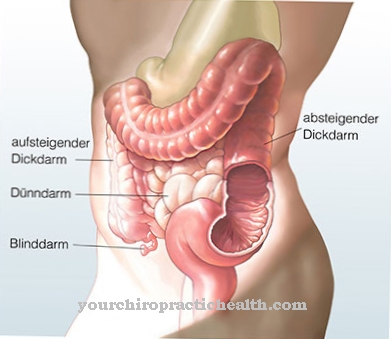Eclampsia is the most severe form of pregnancy poisoning. The pregnant woman may have seizures in which the patient can even fall into a coma. Before eclampsia occurs, there is usually preeclampsia. This usually manifests itself in an increased blood pressure and an increased excretion of protein by the kidneys.
What is eclampsia?

© Valentina Fezova - stock.adobe.com
Eclampsia is a serious condition in pregnancy that is often accompanied by seizures. These seizures are similar to epileptic seizures. Preeclampsia occurs in about 5 percent of all pregnancies, the consequence of which is eclampsia.
A too high protein content in the urine (proteinuria) and high blood pressure are the first signs of preeclampsia. The actual eclampsia can occur as early as the 20th week of pregnancy and persist up to 6 weeks after delivery. However, permanent damage to the mother can be excluded.
causes
If a pregnant woman suffers from eclampsia, there is insufficient blood flow to the placenta. The reason for this is that the blood vessels cannot develop large enough. For the child to be supplied with nutrients and oxygen, however, a good blood supply to the placenta is of great importance. As a result, the mother's blood pressure rises, which improves the child's care.
In this context, signal substances are also sent out by the placenta, through which the kidneys and thus also the excretion of protein are changed. The exact causes of the disruption in the development of the blood vessels of the placenta have not been established with certainty.
Nevertheless, at least certain factors are known in medicine that are responsible for the increase in the risk of developing eclampsia. Eclampsia occurs primarily in primiparous women and in young pregnant women under the age of 20. Obesity, diabetes and a tendency to thrombosis in pregnant women are also risk factors. Women whose mothers already had eclampsia are also at increased risk.
Symptoms, ailments & signs
Eclampsia usually occurs in the last trimester of pregnancy, less often directly at birth or after birth. The disease is serious, so patients must be observed and treated in intensive care. Eclampsia is usually preceded by what is known as preeclampsia. The first signs are excessive water retention, protein excretion in the urine and very high blood pressure.
However, these symptoms can also have other causes, so a medical evaluation is urgently needed. If the patient visits the doctor in good time or, even better, the hospital straight away, a reliable diagnosis can be made. Eclampsia can also be caused by the mother being very overweight.
Eclampsia is characterized by severe seizures that are very similar to those of epilepsy. Loss or loss of consciousness may occur during the seizures. Heralds are severe headaches, a flicker in front of the eyes as well as various neurological deficits, dizziness up to vomiting, visual impairments. Comatose states can even occur during eclampsia.
If risk factors are present, it is advisable to arrange preventive monitoring with the doctor as well as regular check-ups. In addition to obesity, multiple pregnancy is one of the greatest risks; eclampsia usually occurs in first-time mothers. However, there are exceptions, so any complaints should be taken seriously in any case.
Diagnosis & course
It is important to recognize and treat preeclampsia at an early stage in order to avoid eclampsia. This is why the patient's blood pressure is measured during all preventive examinations during pregnancy. In addition, the urine is tested for protein content.
As soon as preeclampsia is suspected, further blood pressure measurements are necessary. In order to determine kidney values, liver values, number of blood platelets and the factors of blood clotting, blood is also taken. With the help of a color-coded ultrasound, the blood flow to the placenta is determined and the child's condition is checked regularly.
An anamnesis is also taken when the diagnosis is made. The typical symptoms of preeclampsia include high blood pressure and proteinuria as well as water retention (edema) in mostly atypical areas such as the hands and face. A sudden increase in weight can be the first sign of edema. Many patients also suffer from visual disturbances, headaches and so-called double vision as well as nausea. Often times the liver is also involved when preeclampsia starts very quickly.
Signs of this include nausea and severe abdominal pain in the right side. It can also lead to a sometimes dramatic deterioration in the health of the expectant mother. The course of eclampsia always depends on the early detection and treatment of preeclampsia. Complications such as stunted growth, detachment of the placenta and in the worst case even the death of the unborn child can occur as complications of eclampsia.
When should you go to the doctor?
If you notice a sudden significant increase in weight with increasing headache and nausea, you may have preeclampsia. It is advisable to consult a doctor immediately. At the latest when signs of eclampsia - high blood pressure, edema on the hands and face, visual disturbances and others - appear, this must be clarified medically. Particularly at risk are pregnant women who are very overweight, aged (over 35 years) or have family predispositions.
Women who belong to these risk groups should have visual disturbances, headaches in the forehead and temples and other typical symptoms clarified quickly. Signs of a seizure and cardiovascular problems are also best addressed with a gynecologist. If you suddenly feel severe illness, the doctor must be notified immediately.
With right-sided abdominal pain and diarrhea, the liver may be affected - a clear warning sign of eclampsia. To rule out further complications, the disease must be clarified in any case and treated if necessary. In severe cases, this requires hospitalization.
Doctors & therapists in your area
Treatment & Therapy
Eclampsia is generally caused by pregnancy, which is why treatment is generally associated with termination of pregnancy. The actual time of delivery is always made dependent on the state of health of the expectant mother and the week of pregnancy.
If the patient has only mild preeclampsia, the patient is admitted to the hospital. There the patient receives high-protein food and has to stay in bed while lying on her left side. There is also a regular check of the condition of mother and child.
If the eclampsia occurs before the 34th week of pregnancy, the administration of cortisol accelerates the child's lung maturation. Birth is initiated from the 36th week of pregnancy. If the expectant mother suffers from severe preeclampsia, she is given sedatives and magnesium sulfate to prevent seizures. Furthermore, a drug-based blood pressure lowering takes place. In this case, attempts are made to postpone the birth up to the 36th week of pregnancy if the mother's state of health allows it.
If a seizure occurs during eclampsia, it is stopped with sedatives and the birth is initiated. Even after the birth, the mother must be strictly monitored, because even then seizures can still occur. Consequential damage from eclampsia is not to be feared if the mother is treated accordingly, but there is an increased risk in a further pregnancy.
Outlook & forecast
Previously, the occurrence of eclampsia in pregnant women was equivalent to a death sentence. Today the forecast is a little more favorable. An early onset of eclampsia in the early stages of pregnancy worsens the prognosis. The course of the so-called preeclampsia is then more dramatic. If left untreated, preeclampsia leads to eclampsia, which is accompanied by seizures. Even today, these mean mortal danger for mother and child.
The prognosis of eclampsia is improved by better education of the expectant mothers and pregnancy examinations. As soon as the first signs of pregnancy preeclampsia appear, doctors try to improve the prognosis by taking appropriate measures. The associated high blood pressure endangers the child if it persists for a long time. If vascular damage to the placenta occurs as a result of preeclampsia, the oxygen and nutrient supply of the child is at risk.
The prognosis for survival for the unborn child worsens if the blood pressure is lowered too quickly. The earlier preeclampsia occurs in pregnancy, the more vulnerable the unborn child is. If preeclampsia occurs later, the chances for the child are better. The unborn child has a 50:50 chance if it comes to severe forms of the so-called HELLP syndrome. It is a complication of preeclampsia. This occurs in 4 to 12% of pregnant women who have severe preeclampsia.
prevention
Because of its imprecise causes, the prevention of eclampsia consists primarily in the early detection and treatment of preeclampsia. Life-threatening complications for mother and child can thus be prevented. The best prevention of eclampsia is above all to keep all prenatal appointments with a gynecologist and / or midwife.
Aftercare
In most cases of eclampsia, there are very few or no follow-up options available to those affected. The focus of the disease is a very early diagnosis and subsequent treatment so that there are no further compilations or even death of the person concerned. Therefore, a doctor should be consulted at the first signs of eclampsia so that the disease can be treated by a doctor as soon as possible.
Self-healing cannot occur. In most cases, people affected by this disease are dependent on taking medication to alleviate the symptoms. The doctor's instructions regarding the dosage should always be followed. An inpatient stay in a hospital is also recommended in order to properly monitor the values of the expectant mother and to identify any discrepancies immediately.
If eclampsia is recognized and treated early on, it can be limited relatively well so that there is no further damage to the child or mother. Many women also rely on the help and support of their partner and their own family so that there is no psychological upset or depression.
You can do that yourself
Eclampsia is a medical emergency that usually occurs after the 30th week of pregnancy, during or shortly after the birth. Affected women are in acute danger of death and must immediately notify the emergency doctor or, if they are already or still in the clinic, the nursing staff.
The most important self-help measure is to recognize the preliminary stage of eclampsia, so-called preeclampsia, as such and to have it treated. In addition to high blood pressure, signs of preeclampsia are primarily water retention in the tissue, nausea, constant nausea that does not only occur in the morning, dizziness, eye fibrillation and other visual disturbances or confusion. If preeclampsia changes to eclampsia, severe headaches and seizures are usually added.
Women who experience such symptoms during pregnancy should see their gynecologist immediately. In addition, pregnant women should have all recommended preventive examinations carried out, as the onset of preeclampsia can be detected and treated promptly before it becomes life-threatening. These preventive examinations are particularly important for high-risk patients. These include women under the age of 18 or over 35, women who are very overweight and women who suffered from high blood pressure before pregnancy.
Pregnant women who are at increased risk of eclampsia should choose their maternity hospital carefully and make sure that a doctor is always available immediately. In these cases, it is essential to refrain from giving birth at home.




.jpg)

.jpg)

















.jpg)



